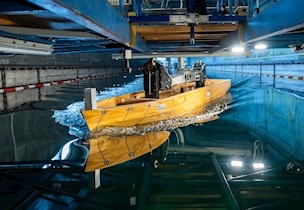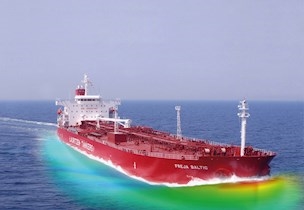Seakeeping evaluation
Many ships will have to cope with harsh weather influencing safety and comfort onboard the vessel. Passenger ships require good seakeeping characteristics to ensure the passengers’ comfort and avoid seasick passengers.
Good seakeeping performance is essential to many ships and offshore structures. Dealing with a passenger ship, the vertical and lateral accelerations and the roll angle has huge impact on the operational profile and not least the passenger comfort. Passenger ships, for example, require good seakeeping characteristics to ensure the passengers’ comfort and avoid green water on deck and slamming.
For a successful vessel design, good seakeeping characteristics should be incorporated into the design in the initial design phases. At this stage, it is still possible to vary the geometry of the hull or structure or to change other design parameters that are critical with respect to wave forces and/or vessel motions. Therefore, it is important to have reliable prediction tools at hand in the initial design phase.
Typical measurements include:
For a successful vessel design, good seakeeping characteristics should be incorporated into the design in the initial design phases. At this stage, it is still possible to vary the geometry of the hull or structure or to change other design parameters that are critical with respect to wave forces and/or vessel motions. Therefore, it is important to have reliable prediction tools at hand in the initial design phase.
Numerical seakeeping
We offer numerical seakeeping predictions based on a 3D linear radiation-difraction panel code (S-Omega).With these tools, we can calculate the motion response of the ship, wave forces, added mass and damping for different operational profiles of sea states, speeds and headings. Furthermore, the tools can produce operability analysis for a given sea state and mission with its specific restrictions.
Tank test
We use the still water tank to test ship model for the seakeeping tests. In the seakeeping set-up, the ship model is fully equipped with powering and autopilot steering control, thus allowing a free-sailing mode (6-DOF) in the generated irregular (or regular) sea states. The ship model is further instrumented to measure seakeeping parameters.Typical measurements include:
- 6-DOF vessel motion
- wave elevations
- propeller(s) thrust
- torque and rate of revolutions
- vertical and/or transverse accelerations at specified points
- observation/documentation of rarely occurring events (slamming, deck wetness, green water, propeller immergence, etc.)
Based on the measured data, the following general seakeeping parameters are reported: encounter wave spectrum, 6-DOF motions (in the form of response functions), statistics and power spectra of the measured accelerations, added power in waves and associated speed loss, rarely occurring events.



